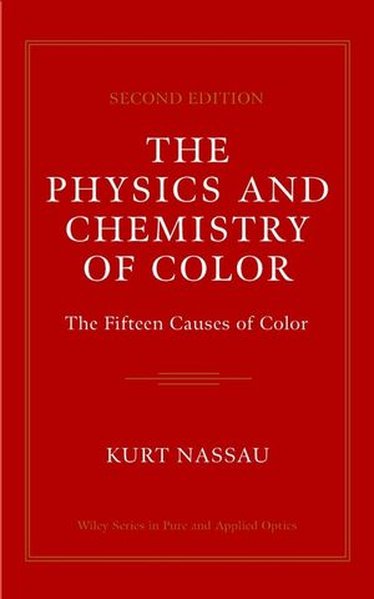
Zustellung: Mo, 28.07. - Sa, 02.08.
Versand in 3-4 Wochen
VersandkostenfreiDie 2. Auflage dieses angesehenen Titels behandelt die physikalischen und chemischen Aspekte der 15 Ursachen der Farbentstehung. Hier geht es um Fragen, wie das Chlorophyll im Gras die grüne Farbe erzeugt, warum der Himmel und manche Augen blau sind, warum der Rubin rot aussieht, welchem Prozess das Gold seine gelbe Farbe verdankt und warum der Opal und die Flügel mancher Schmetterlingsarten alle Farben des Regenbogens in sich vereinen. Dieses Buch vermittelt die notwendigen Grundlagen, um diese Prozesse zu verstehen. Besondere Vorkenntnisse sind nicht erforderlich. Mit Beispielen zur Farbbildung aus verschiedenen Bereichen, z.B. Pigmente, Farbstoffe, Metalle, Mineralien, Edelsteine, atmosphärische Phänomene usw. "The Physics and Chemistry of Color" füllt eine echte Lücke zwischen Fachmonographien und der allgemeineren Literatur.
An updated and revised second edition of the acclaimed classic
Have you ever wondered why the sky is blue, or a ruby red? This classic volume studies the physical and chemical origins of color by exploring fifteen separate causes of color and their varied and often subtle occurrences in biology, geology, mineralogy, the atmosphere, technology, and the visual arts. It covers all of the fundamental concepts at work and requires no specialized knowledge.
Author Kurt Nassau includes hundreds of illustrations, tables, and photographs-as well as end-of-chapter problems-that aid in visualizing the concepts discussed. An updated bibliography permits readers to pursue their own particular interests and an expanded series of appendices cover advanced topics.
The Physics and Chemistry of Color, Second Edition is a one-of-a-kind treatment of color that provides both detailed physical and chemical properties of color and a more general overview of the subject. It will prove highly useful to specialists and non-specialists alike-and fascinate those with varied interests from optics to art history.
Have you ever wondered why the sky is blue, or a ruby red? This classic volume studies the physical and chemical origins of color by exploring fifteen separate causes of color and their varied and often subtle occurrences in biology, geology, mineralogy, the atmosphere, technology, and the visual arts. It covers all of the fundamental concepts at work and requires no specialized knowledge.
Author Kurt Nassau includes hundreds of illustrations, tables, and photographs-as well as end-of-chapter problems-that aid in visualizing the concepts discussed. An updated bibliography permits readers to pursue their own particular interests and an expanded series of appendices cover advanced topics.
The Physics and Chemistry of Color, Second Edition is a one-of-a-kind treatment of color that provides both detailed physical and chemical properties of color and a more general overview of the subject. It will prove highly useful to specialists and non-specialists alike-and fascinate those with varied interests from optics to art history.
Inhaltsverzeichnis
Preface to the Second Edition.
Preface to the First Edition.
Acknowledgments for the Second Edition.
Acknowledgments for the First Edition.
LIGHT AND COLOR.
Some Fundamentals: Color, Light, and Interactions.
COLOR INVOLVING VIBRATIONS AND SIMPLE EXCITATIONS.
Color Produced by Incandescence.
Color Produced by Gas Excitations.
Color Produced by Vibrations and Rotations.
COLOR INVOLVING LIGAND FIELD EFFECTS.
Color Caused by Transition Metals in a Ligand Field.
COLOR INVOLVING MOLECULAR ORBITALS.
Color in Organic Molecules.
Charge Transfer Color.
COLOR INVOLVING BAND THEORY.
Color in Metals and Semiconductors.
Color Centers.
COLOR INVOLVING GEOMETRICAL AND PHYSICAL OPTICS.
Dispersive Refraction and Polarization.
Scattering and Nonlinear Effects.
Interference and Diffraction.
COLOR-RELATED TOPICS.
Colorants of Many Types.
Vision, Luminescence, Lasers, and Related Topics.
Appendix A: Units, Chromaticity, and Color Order Systems.
Appendix B: Incandescence Equations.
Appendix C: Atoms and Simple Molecules.
Appendix D: Crystal Fields, Ligand Fields, and Molecular Orbitals.
Appendix E: Band Theory.
Appendix F: Prism, Thin Film, and Layer Diffraction Grating.
Appendix G: Recommendations for Additional Reading.
Index.
Preface to the First Edition.
Acknowledgments for the Second Edition.
Acknowledgments for the First Edition.
LIGHT AND COLOR.
Some Fundamentals: Color, Light, and Interactions.
COLOR INVOLVING VIBRATIONS AND SIMPLE EXCITATIONS.
Color Produced by Incandescence.
Color Produced by Gas Excitations.
Color Produced by Vibrations and Rotations.
COLOR INVOLVING LIGAND FIELD EFFECTS.
Color Caused by Transition Metals in a Ligand Field.
COLOR INVOLVING MOLECULAR ORBITALS.
Color in Organic Molecules.
Charge Transfer Color.
COLOR INVOLVING BAND THEORY.
Color in Metals and Semiconductors.
Color Centers.
COLOR INVOLVING GEOMETRICAL AND PHYSICAL OPTICS.
Dispersive Refraction and Polarization.
Scattering and Nonlinear Effects.
Interference and Diffraction.
COLOR-RELATED TOPICS.
Colorants of Many Types.
Vision, Luminescence, Lasers, and Related Topics.
Appendix A: Units, Chromaticity, and Color Order Systems.
Appendix B: Incandescence Equations.
Appendix C: Atoms and Simple Molecules.
Appendix D: Crystal Fields, Ligand Fields, and Molecular Orbitals.
Appendix E: Band Theory.
Appendix F: Prism, Thin Film, and Layer Diffraction Grating.
Appendix G: Recommendations for Additional Reading.
Index.
Produktdetails
Erscheinungsdatum
27. Juli 2001
Sprache
englisch
Auflage
2nd edition
Seitenanzahl
520
Autor/Autorin
Kurt Nassau
Verlag/Hersteller
Produktart
gebunden
Gewicht
853 g
Größe (L/B/H)
242/162/29 mm
ISBN
9780471391067
Pressestimmen
"...a fascinating journey into the world of colour." (Chemistry in Britain, January 2002)
"excellent survey covering all aspects of the chemistry and physics of colour" (Asia Pacific Coatings Journal, December 2001)
"No-one could read this book without learning something new about the world of colour." (Chemistry & Industry, 3 June 2002)
"excellent survey covering all aspects of the chemistry and physics of colour" (Asia Pacific Coatings Journal, December 2001)
"No-one could read this book without learning something new about the world of colour." (Chemistry & Industry, 3 June 2002)
Bewertungen
0 Bewertungen
Es wurden noch keine Bewertungen abgegeben. Schreiben Sie die erste Bewertung zu "The Physics and Chemistry of Color" und helfen Sie damit anderen bei der Kaufentscheidung.







